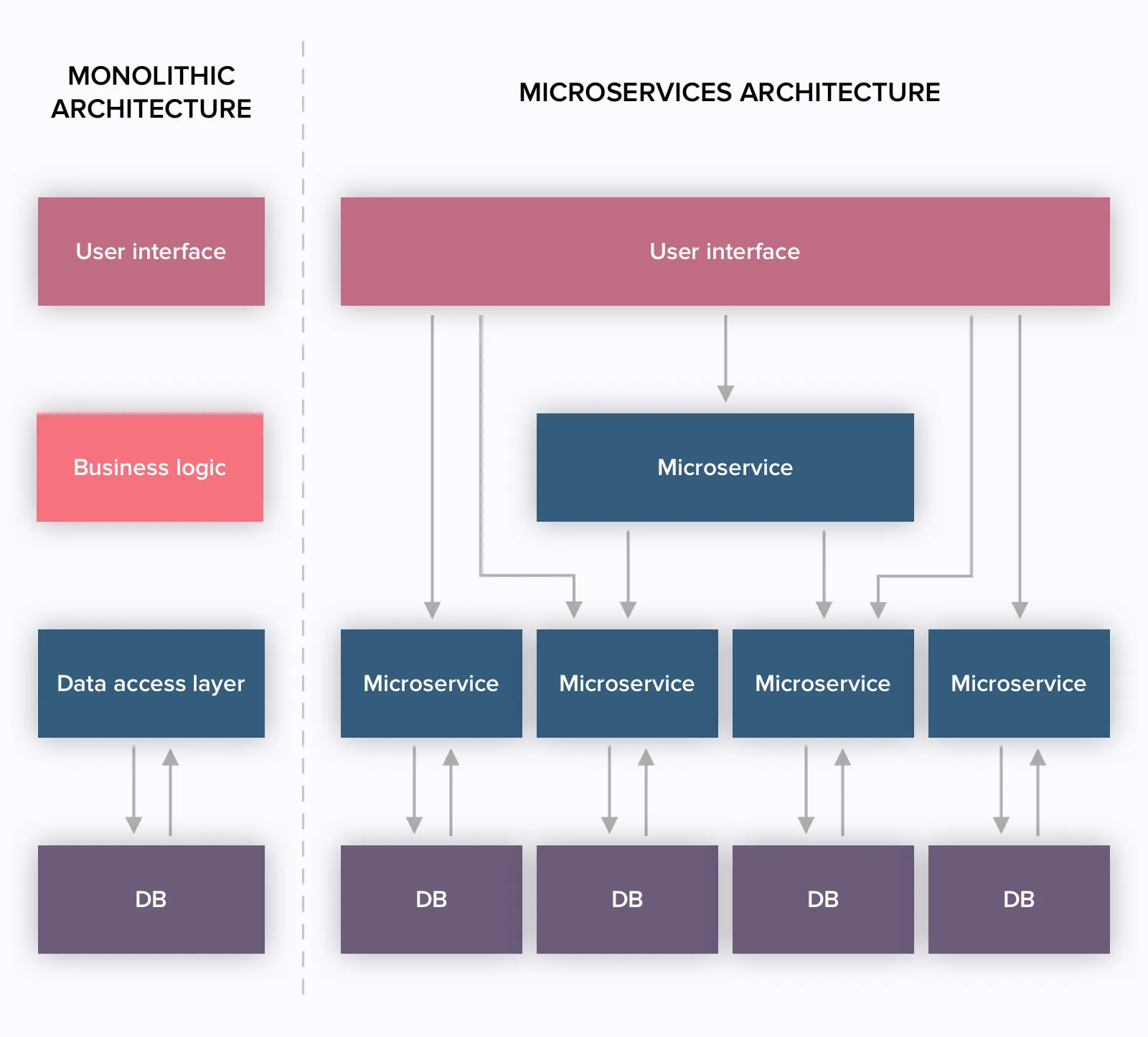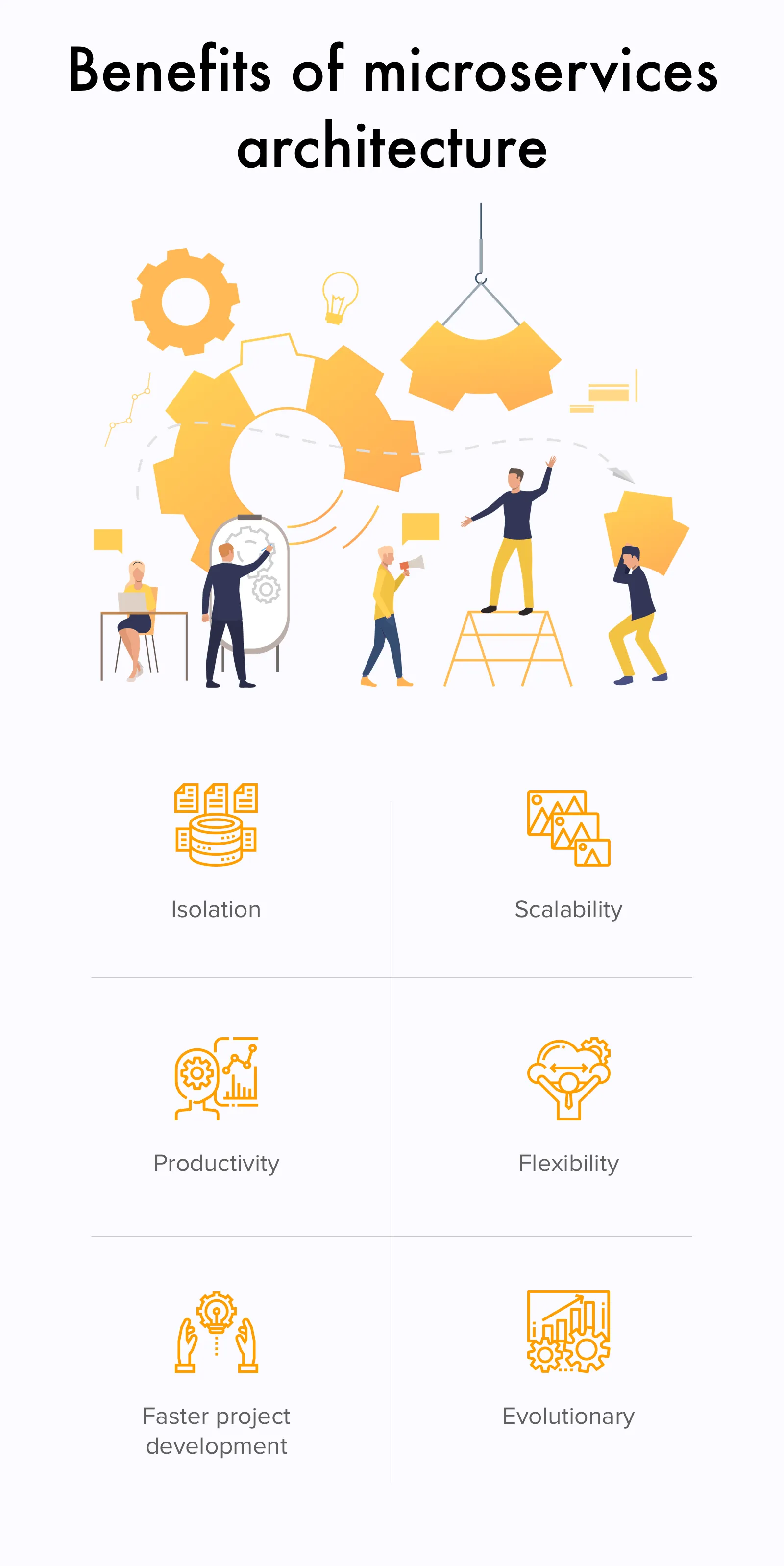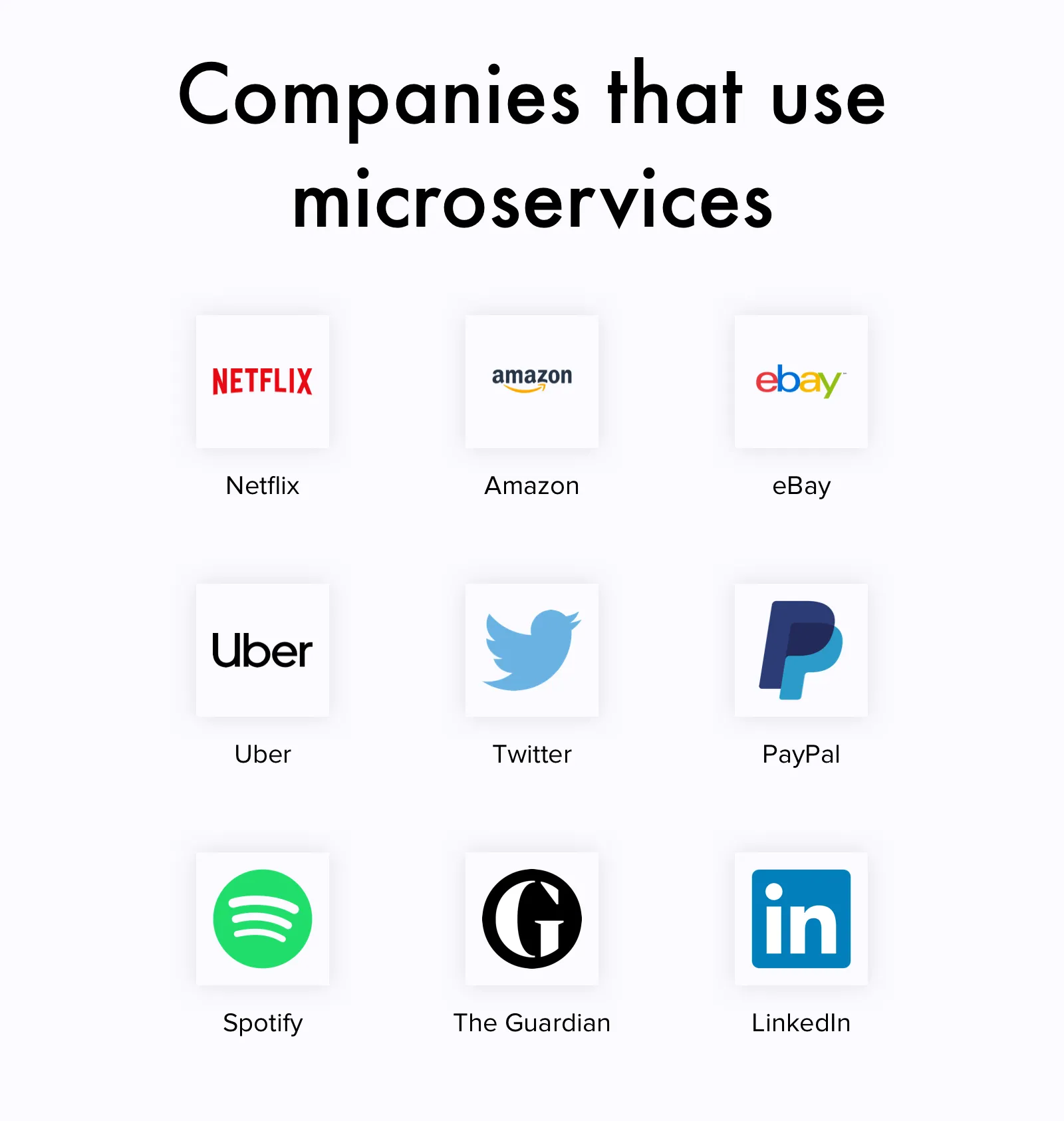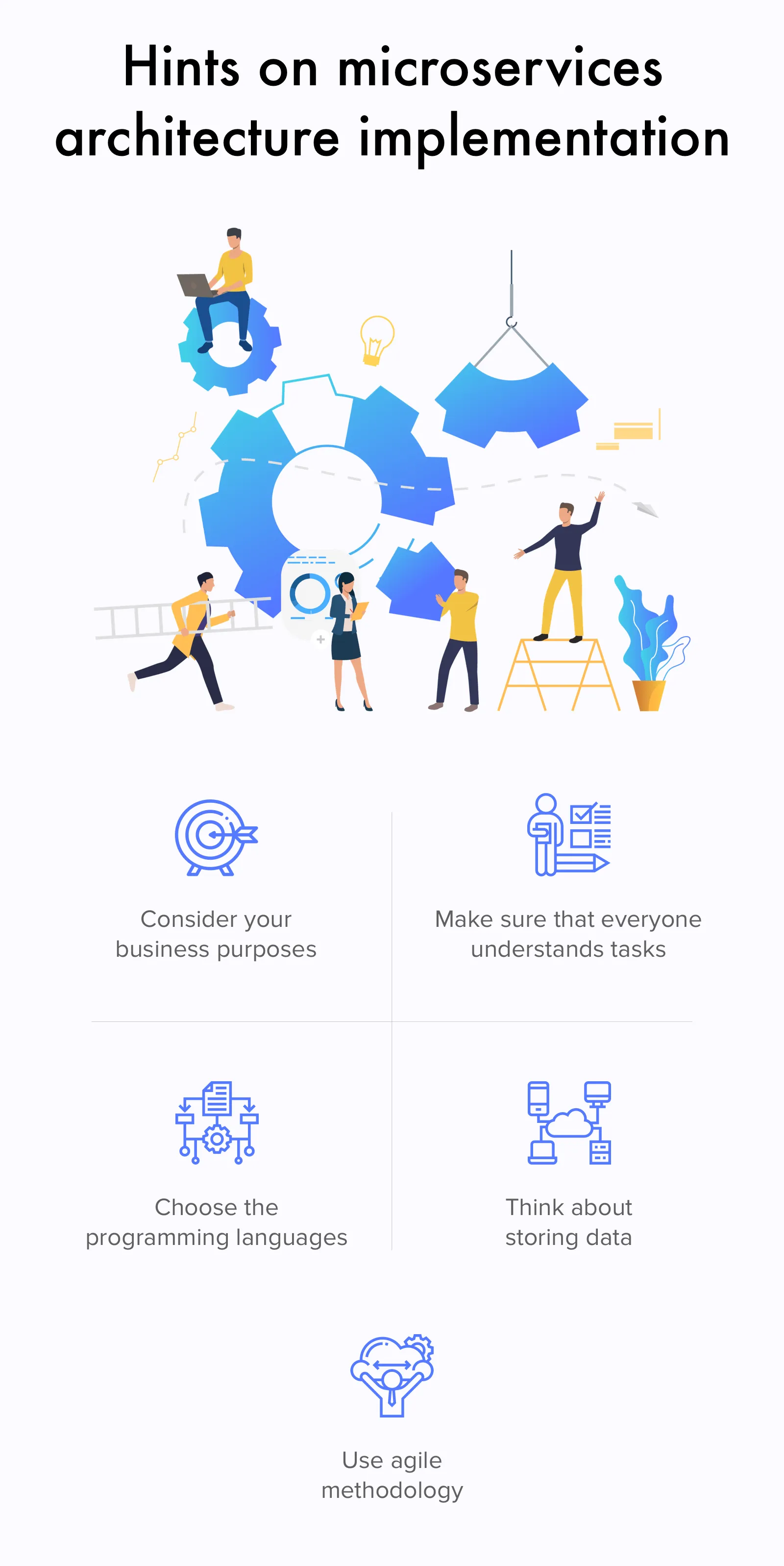6 Major Benefits of Microservices Architecture
09 Jul 2019
11 Min
4844 Views
When you want to start the new project development, there is always a question of what architecture to choose. There are two possible variants: monolithic architecture that is considered traditional and microservices.
Microservices architecture can speed up the software development service by setting the new way of writing and shipping code. According to the last research, 63% of enterprise-level companies had taken steps to integrate this approach into their software.
What Is Microservices Architecture?
The concept of microservices is based on a simple idea: the developer creates separate parts of the application instead of one whole. To understand microservices architecture better, it’s necessary to compare it with traditional monolith model.

Monolithic vs microservices architecture diagram
Monolithic Architecture
A lot of developers consider this architecture as a traditional way to create applications. Monolithic architecture means that every part of the app is connected to one another. So, each part of the project has to work as intended to get a smoothly working end product.
The typical monolithic architecture consists of three parts: a database, a client-side user interface, and a server-side of the app. In other words, back-end and front-end logic along with background tasks are all gathered in one code base. So, if software engineers want to change or update something, they’ll have to develop and deploy the whole stack at once.
Discover important tips on how to choose web development stack for your project
Microservices Architecture
Microservice architecture is an approach that allows creating an application from a combination of small services. Each of these components is created individually and deployed separately. As a result, they run their own processes. The services communicate with each other utilizing lightweight APIs.
This method is good for large and complex projects because the services aren’t interdependent and can be changed without damage for other blocks.
Why Use Microservices Architecture?
A lot of developers hesitate about switching to this architecture. However, there are several significant benefits of microservices. For instance, applications built as a combination of independent components is easier to test, understand, and maintain.
Microservices allow companies to improve workflows and increase productivity. This approach has already proven to be a good system for creating big, enterprise-level applications. Usually, such apps are developed by distributed teams, so it’s easier for them to choose microservices architecture. Besides, there are more microservices architecture advantages outlined below.
Isolation
Microservices are profitable due to their isolation and resilience. What does it mean? If one of the components fails, the developers have an opportunity to use another one while the application continues to work independently. As a result, software engineers can build and deploy necessary services without changing the whole app.
Scalability
Since microservices architecture is based on small components, it’s easier for them to scale up and down following all the requirements for one certain component. Isolation provides an application with an opportunity to function properly even during the large changes. As a result, microservices architecture is a perfect approach for companies working with many platforms and devices.
Ready to dive into the microservices architecture and looking for a reliable vendor? Drop us a line and get your project estimation for FREE.
Productivity
If you want to expand your team of developers, microservices are better to use. It’s easier to understand the small pieces of functionality than an entire monolithic application.
Flexibility
This approach allows utilizing the right tool for the right task. Developers can build each server utilizing appropriate programming language or framework. However, the created services don’t lose the ability to communicate with each other.
Faster project development
Since microservices work independently, you don’t have to change the codebase to add or modify any feature. You make changes only to one certain component. After that, it can be tested and deployed individually. As a result, you can deliver your application to the market faster.
Evolutionary
Microservices architecture is a perfect option if software engineers can’t fully predict what kind of devices the application will be used on. Using the microservices approach, the developers can provide fast and controlled upgrades without slowing or stopping the application.

Advantages of microservices
Wrapping up this part, microservices architecture offers unique opportunities to increase productivity, choose the perfect tool, and so on. However, this approach has disadvantages. For example, utilizing different coding languages, frameworks, libraries can paralyze the team if they aren't ready for such independence. But if you have large and complex application and plan to scale the solution, microservice architecture is a perfect choice.
Companies Using Microservices and Their Successful Stories
Having studied what microservices architecture is and looked through the benefits of using this technology, it’s high time to explore companies that have already started to use microservices architecture.

Companies that use microservices architecture
So, it’s high time to discuss several successful stories of implementing a microservices architecture.
Netflix
Netflix is one of the best examples of implementing a microservices architecture. In 2015, the company got the Special Jury Award for bringing huge influence on innovations in the IT field.
In 2009, Netflix decided to move from a monolithic architecture to microservices due to increasing demand for their service. However, those days the term ‘microservices’ didn’t exist, the engineers created an open source technology focused on offering the best Internet television network.
Attention! It was discovered how to create a streaming service: tools, MVP, costs
Moving to microservices architecture approach allows developers to deploy thousands of code sections every day. It’s important to mention that Netflix is quite open about their moving process. The company has even put up some examples from the platform code on Github.
Nowadays, Netflix provides 193 million subscribers with approximately 10 billion hours of TV shows and movies.

Microservices: Netflix
eBay
eBay is a large online marketplace that became a great microservices implementation example. Steven Fisher, the CTO of eBay, claims that there are more than 1,000 services. Additionally, there are many development teams because one team is responsible for the determined set of services.
Implementing microservices architecture allows the team to remove unnecessary dependencies, allocate development work and add new features easier.

Microservices: Ebay
Uber
Just like any other startup, Uber had a monolithic architecture of the application at the beginning. It was simpler for the founders since the company was working in San Francisco and only provided clients with the UberBLACK service.
How to start a business like Uber? Examine its business model and revenue generation strategy in our detailed guide
The startup started to grow quite fast, so the developers decided to follow the way of other companies like Netflix, Amazon, and eBay and move to a microservices architecture. The main reason for this transformation was the ability to use various programming languages and frameworks.
Currently, Uber has more than 1,300 microservices that focus on improving the scalability and reliability of the app.

Microservices: Uber
Spotify
There are over 75 million active monthly users on Spotify. As a result, the founders of the company decided to create a system that scales components independently. So, the microservice architecture was developed in order to make the synchronization easier.
The team of Spotify’s developers is quite big. There are around 600 software engineers that create 90 teams.
Spotify claims that the main advantage of microservices architecture is an ability to prevent large failures. Microservices allows the company to have many services failed simultaneously without any harm for the users.

Microservices: Spotify
Amazon
This enterprise has also decided to switch to microservices architecture. The main reason for moving to this approach was the revenue losses caused by the downtime of servers.
Amazon’s developers focused on simplifying the processes. For instance, since microservices implementation, the engineers created a server calculating taxes at the checkout.
Moreover, integrating AWS (Amazon Web Services) cloud for microservices allows them to scale up and down depending on the traffic and reduce expenses. Microservices architecture provides the developers with the opportunity to deploy code easily and more often. For example, now Amazon developers deploy code every 11,7 seconds.

Microservices: Amazon
How to Implement Microservices Architecture?
Of course, there are a lot of benefits from switching to a microservices architecture like increasing developers’ productivity, automated testing, faster deployment. However, you may face some pitfalls like unprepared employees or unexpected expenditures.
So, we’ve prepared several tips that can guide you at the beginning of introducing microservices architecture.
#1. Think about Your Business Purposes
One of the first steps along the path of microservices architecture implementation is finding out if your business really needs this technology. For example, you already have a working server. Due to microservices implementation, you can get 100 services that need to be managed. As a result, a lot of parts of work should be automated.
Microservices architecture is beneficial for large enterprises that conquers a lot of processes every single day. However, if you only start your business, it’s better to choose the traditional monolithic approach.
#2. Ensure That Everybody Understands the Task
Before starting to write the code, it’s better to make sure that the members of your team have appropriate knowledge and skills. For example, such skills as data modeling, asynchronous programming, API development, experience in Docker are vital for successful integration.
#3. Choose the Coding Language
The software developers tend to create monolithic applications using one programming language or platform. However, microservices allow utilizing various languages and frameworks.
As a result, it’s important to discuss the tech stack of your app beforehand.
#4. Consider Storing Data
The database is an important part of your application. Moving from monolithic architecture, it’s necessary to come up with the strategy to split the DB into several tiny databases. So, each built microservice needs to have its own database and domain data. This provides an opportunity to deploy microservices individually.
#5. Agile Methodology
Migrating to microservices architecture requires small agile teams of software engineers. For example, if there is one big team of developers, it’s necessary to reorganize them into several teams and allow them to work more independently.
Moreover, it’s better to study project management tips beforehand in order to synchronize the work properly.

Tips on how to implement microservices
So, there were five main hints on implementing a microservices architecture. As you can see, before integrating this powerful technology you need to prepare your team as well as consider all possible pitfalls. The successful transformation depends on your developers, the right strategies and technologies.
The Bottom Line
Of course, microservices architecture has advantages and disadvantages. Without any doubt, this approach is profitable for fast growing solutions and an agile team of the developers. Microservices allow avoiding many hidden pitfalls that are common to monolithic architecture.
If you want to move from a monolithic architecture to microservices, we can assist you. Cleveroad is a software development company that is located in Eastern Europe. Our team of software engineers has enough experience in developing applications with monolithic or microservices architecture. So, whether you have questions about microservices, fill our contact form and our managers will get back to you within 24 hours.
Microservices architecture is an approach that allows creating an application from a combination of small services. Each of these components is made individually and deployed separately. As a result, they run their own processes and communicate with each other utilizing lightweight APIs.
The microservices concept is based on a simple idea: the developer creates separate parts of the application instead of one whole.
Microservices allow companies to improve workflows and increase productivity:
- developers build and deploy services without changing the whole app
- it's easier to scale up and down
- it's easier to understand the small pieces of functionality
- deliver your application to the market faster
- developers provide fast and controlled upgrades without slowing or stopping the application
The benefits of microservices are:
- Isolation
- Scalability
- Productivity
- Flexibility
- Faster project development
- Evolutionary
Yes, Amazon does use microservices. Same for Netflix, eBay, Uber, Spotify, and lots of other tech giants.
Here's the difference:
- Monolithic architecture means that every part of the app is connected to one another. Each part of the project has to work as intended to get a smoothly working end product.
- Microservice architecture allows creating an app from a combination of small services. Each of these components is designed individually and deployed separately.

Evgeniy Altynpara is a CTO and member of the Forbes Councils’ community of tech professionals. He is an expert in software development and technological entrepreneurship and has 10+years of experience in digital transformation consulting in Healthcare, FinTech, Supply Chain and Logistics
Give us your impressions about this article
Give us your impressions about this article